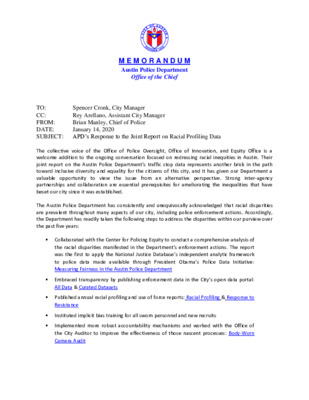Back Up - #9-Memo from Chief Manley responding to Joint Rpt of the OPO — original pdf
Backup

M E M O R A N D U M Austin Police Department Office of the Chief Spencer Cronk, City Manager Rey Arellano, Assistant City Manager Brian Manley, Chief of Police January 14, 2020 TO: CC: FROM: DATE: SUBJECT: APD’s Response to the Joint Report on Racial Profiling Data The collective voice of the Office of Police Oversight, Office of Innovation, and Equity Office is a welcome addition to the ongoing conversation focused on redressing racial inequities in Austin. Their joint report on the Austin Police Department’s traffic stop data represents another brick in the path toward inclusive diversity and equality for the citizens of this city, and it has given our Department a valuable opportunity to view the inter-agency partnerships and collaboration are essential prerequisites for ameliorating the inequalities that have beset our city since it was established. The Austin Police Department has consistently and unequivocally acknowledged that racial disparities are prevalent throughout many aspects of our city, including police enforcement actions. Accordingly, the Department has readily taken the following steps to address the disparities within our purview over the past five years: issue from an alternative perspective. Strong Collaborated with the Center for Policing Equity to conduct a comprehensive analysis of the racial disparities manifested in the Department’s enforcement actions. The report was the first to apply the National Justice Database’s independent analytic framework to police data made available through President Obama’s Police Data Initiative: Measuring Fairness in the Austin Police Department Embraced transparency by publishing enforcement data in the City’s open data portal: All Data & Curated Datasets Published annual racial profiling and use of force reports: Racial Profiling & Response to Resistance Instituted implicit bias training for all sworn personnel and new recruits Implemented more robust accountability mechanisms and worked with the Office of the City Auditor to improve the effectiveness of those nascent processes: Body-Worn Camera Audit Contracted with Dr. Alex Del Carmen, an expert on racial profiling and discrimination, to regularly audit the Department’s racial profiling data to ensure accuracy in collection and reporting Hired a Development and Training Manager with a doctorate in psychology and expertise in cross-cultural perspectives to develop and execute curriculum review strategies and assess teaching and learning methodology at the Training Academy: Statesman Editorial Partnered with community stakeholders and justice advocates to enact critical policy changes pertaining to use of force and de-escalation, traffic enforcement, and interactions with foreign nationals: APD General Orders Reduced discretionary arrests for citation-eligible offenses from 1,557 in 2017 to 252 through the first three quarters of 2019. Arrests of Black individuals dropped from 477 to 70 during that time period. The Department also holds a monthly working group with community members to explore additional strategies for addressing disparities in enforcement actions. The results are published quarterly on the City’s website: Freedom City Reports Streamlined the process to gather feedback from the community about interactions with our officers, both positive and negative: Office of Police Oversight Focused on increasing diversity and advancing community policing and engagement through recruiting, cadet training, continuing education, and retention practices: Matrix Report Worked with the City’s Equity Office to develop a forthcoming Equity Assessment Tool to evaluate the impact of existing City/Department policies on racial equity, with the goal of utilizing the tool to implement new policies, practices, and programs to help identify and address the inequities that impact the quality of life for low-income communities, which are disproportionately communities of color: Equity Assessment Tool (Pilot) Despite all of these efforts, disparities have persisted. The Department is eager to achieve more substantive progress and believes the Department, City leaders, and community can work together to reach this goal through the following actions: Move beyond the reliance on Census population data as the sole benchmark for analyzing racial disparities in police enforcement actions. Due to the confluence of complex factors that contribute to disparate outcomes, researchers and scholars have widely dismissed the utilization of population data, by itself, as an effective basis for making incisive and meaningful interpretations of racial profiling data1. Failure to adequately address the complexities of the issue can mislead the public and policy 1 Sample works (with additional references cited within each respective source): Methods for Assessing Racially Biased Policing (Ridgeway and MacDonald); Toward a Better Benchmark (Alpert, Smith, and Dunham); Data for Change (Hetey, Monin, Maitreyi, and Eberhardt); Testing for Racial Profiling in Traffic Stops From Behind a Veil of Darkness (Grogger and Ridgeway) makers about the various causes of the disparities and result in the adoption of ineffective or inappropriate corrective measures. This is especially vital for a city with a history of systematically segregating its citizens of color, stifling their economic mobility, and neglecting to protect them from the onslaught of urban renewal and gentrification: Mayor’s Task Force on Institutional Racism and Systemic Inequities Contract with a suitable academic institution to conduct an independent, comprehensive, and evidence-informed assessment of the Department’s enforcement practices, cultural norms and customs, training, accountability procedures, and any resulting racial disparities. A similar partnership between the City of Oakland and Stanford University yielded promising results and provided a roadmap for creating community-based strategies aimed at addressing the unique historical and cultural challenges of a particular city: Data for Change & Strategies for Change As recommended in the Joint Report, invest in sophisticated oversight tools that are more adept at identifying, flagging, and tracking at-risk officers in order to facilitate timely and effective interventions: Risk Management Systems Brian Manley Chief of Police